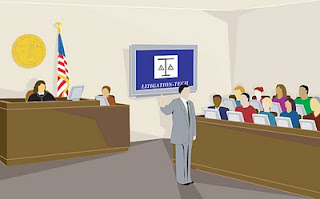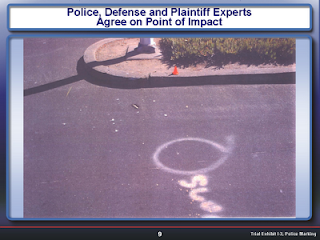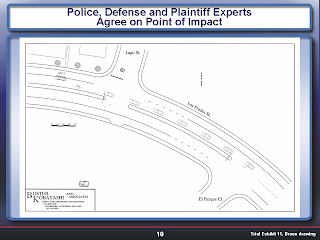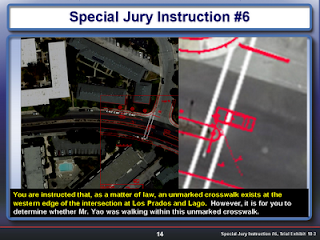I look forward to putting faces with names of so many people in Legal Videography and Trial Presentation this weekend in Miami. I understand that it has been sold out for awhile, with a few last-minute slots available at the door on a first-come, first-served basis.
Please consider joining the Trial Technology LinkedIn Group http://www.linkedin.com/e/vgh/2276605, request to connect with me on LinkedIn http://www.linkedin.com/pub/ted-brooks/0/190/778, and follow me on Twitter: http://twitter.com/litigationtech.
I'll be covering database development and will have a sneak peak of TrialDirector 6!
Also, there are a lot of relevant articles on trial presentation in this blog - happy reading...
---Ted
-->
Home > Archives for February 2010
Wednesday, February 24, 2010
Wednesday, February 17, 2010
ABA Journal Blawg Directory picks up Court and Trial Technology Blawg
ABA Journal Blawg Directory has now added Court and Trial Technology to their list of approved Blawgs:
http://www.abajournal.com/blawg/Court_and_Trial_Technology
Posts cover trial presentation and technology consulting, legal graphics and litigation support.
Author: Ted Brooks is a trial consultant and Founder of Litigation-Tech LLC.
Blawg Related Categories: Trials & Litigation • Evidence • Consultant
http://www.abajournal.com/blawg/Court_and_Trial_Technology
Posts cover trial presentation and technology consulting, legal graphics and litigation support.
Author: Ted Brooks is a trial consultant and Founder of Litigation-Tech LLC.
Blawg Related Categories: Trials & Litigation • Evidence • Consultant
Ted Brooks, President
Litigation-Tech LLC
"Enhancing the Art of Communication" Member, American Society of Trial Consultants
Certified inData TrialDirector Trainer
415-291-9900 San Francisco
Litigation-Tech LLC
"Enhancing the Art of Communication" Member, American Society of Trial Consultants
Certified inData TrialDirector Trainer
415-291-9900 San Francisco
213-798-6608 Los Angeles
www.litigationtech.com
tbrooks@litigationtech.com
www.litigationtech.com
tbrooks@litigationtech.com
http://trial-technology.blogspot.com/
WINNER: LAW TECHNOLOGY NEWS AWARD FOR MOST INNOVATIVE USE OF TECHNOLOGY DURING A TRIAL
WINNER: LAW TECHNOLOGY NEWS AWARD FOR MOST INNOVATIVE USE OF TECHNOLOGY DURING A TRIAL
Tuesday, February 16, 2010
Anatomy of an "Award-Winning" Trial Exhibit
Published recently in CAOC Forum Magazine, here is the complete and unabridged version. If you wish to distribute this article (or any of my articles) for CLE or other presentations, please feel free to request a PDF version.
Anatomy of an “Award-Winning” Trial Exhibit
The Case
Han Zhang Yao, Xiu Ying He, Plaintiffs, v. Mary Bee Thrasher, Et Al., Defendants; County Of San Mateo, Case No. Civ 476627, Judge Carol L. Mittlesteadt. In this case, a pedestrian was struck and severely injured while crossing a street at an intersection which did not have a crosswalk. Plaintiff attorneys Donald Krentsa (Meisel and Krentsa) and Walter “Skip” Walker (Walker, Hamilton & Koenig) retained Trial Consultant Ted Brooks (Litigation-Tech LLC) to assist with trial presentation, graphics and video editing. Walker focused on the liability, with Krentsa covering damages. The defense was handled by Farmers in-house firm Pedersen, Eichenbaum, Lauderdale & Siehl.
A Key Issue
Although several difficult and important issues were involved, as a result of closely analyzing and comparing several exhibits, one of the critical points became whether an unmarked crosswalk existed at the intersection of Lago and Los Prados in San Mateo, CA, and if so, whether Mr. Yao (plaintiff) was within the boundaries of the unmarked crosswalk when he was struck by Mrs. Thrasher’s car.
Exploring the Universe
Several Google Earth satellite images were captured to explore the accident scene, starting from a large area (higher elevation), and moving closer to the intersection with each progressive image. This could be used to help the jury orient themselves as to the location, surrounding areas, etc.
Analyzing the Defense
Defense expert Thomas Braun had prepared a schematic drawing of the intersection, along with plotting the path of both the pedestrian and the auto at one-second intervals, approaching the time and point of impact. The point of impact was determined based upon police photos and accident-scene paint markings.
Upon first inspection, this diagram appeared suspect, as though it were not drawn accurately to scale when comparing with Google Earth satellite images.
The Experts Agree
Independently, Braun and Plaintiff’s expert David Yoshida both agreed on the point of impact, with only a slight difference in the path taken to get to that point. This would prove to be very valuable, since when experts on both sides actually agree on something, it stands pretty firmly.
Combining the Exhibits
The next step in attempting to piece all of the evidence together in a favorable manner was to place Braun’s drawing onto the Google Earth image and see if was accurately drawn. The lines from Braun’s drawing were extracted from the image and overlaid onto one of the Google Earth images. With a bit of adjustment and proper placement, the drawing fit right into place. Although this didn’t result in revealing any problem or inaccuracy with the drawing, it did help us to understand where the drawing came from. Google Earth had apparently been used as a basis for the drawing.
Showing the Jury
David Yoshida testified that the definition of an unmarked crosswalk would be the prolongation of the sidewalks at an intersection. This was displayed and explained to the jury using one of the Google Earth satellite images. Using TrialDirector software, lines were drawn for the jury onto the map which extended from the sidewalk across Los Prados, showing what a crosswalk might look like at the intersection, using a pair of straight blue lines.
With the foundation laid, Walker then displayed the Braun drawing, which, along with the Google Earth images had previously been admitted into evidence. The image showing the overlay on the Google Earth image was then discussed and admitted into evidence.
The Unmarked Crosswalk
With everything now in place, the next thing to be introduced by Yoshida was a graphic which had been created by combining the Braun drawing with the Google Earth image; then adding a white crosswalk as it might appear were it marked in paint, extending across Los Prados, as a prolongation of the sidewalk on Lago.
The “Award-Winning” Exhibit
Once the graphics were all combined, a very favorable discovery was made when the point of impact was magnified. The police and both experts had placed the point of impact within the boundaries of an unmarked crosswalk.
Mr. Yao had been in an unmarked crosswalk when he was struck by Thrasher’s vehicle. When this was displayed to the jury, there were several expressions of surprise and copious notes were taken. This was indeed a golden moment – and did I mention this was also admitted into evidence as an exhibit?
Application of Law
The next step would be trying to establish to the jury that there was indeed an unmarked crosswalk at the intersection. When motions were filed for Jury Instructions, Blanton v. Curry (20 Cal. 2d 793) was used for reference, which the court had also independently researched. Judge Mittlesteadt indicated she was leaning in the Plaintiff’s favor.
After plenty of argument, the ruling went off like a hand-grenade before closing arguments, resulting in the following Jury Instruction:
Special Jury Instruction #6:
You are instructed that, as a matter of law, an unmarked crosswalk exists at the western edge of the intersection at Los Prados and Lago. However, it is for you to determine whether Mr. Yao was walking within this unmarked crosswalk.
The exhibits clearly established that Mr. Yao was indeed within the unmarked crosswalk.
Conclusion
A verdict of $5.55M was reached after about a day and a half of deliberations. The jurors were interviewed and shared that this exhibit was a very effective and important factor in the outcome of the trial.
The actual exhibits admitted into evidence were not “pretty” demonstratives typically used for opening statements or closing arguments. In order to get them into evidence, they must not have argumentative titles or commentary.
The development of this exhibit was the result of looking at things from another perspective. Often, an attorney knows the case so well that the simple things are overlooked or assumed as obvious. A good trial consultant can examine your case and evidence, and perhaps discover things that might otherwise have been missed. They may even be able to help you win your case with an “award-winning” trial exhibit or video.
This was the first time Krentsa and Walker had ever tried a case using technology, but you can bet it won’t be the last.
Ted Brooks has written and presented legal
technology topics for numerous organizations,
including California State Judiciary, U.C. Berkeley,
NITA, ABOTA, LawNet, ADC, DRI, ILTA,
SFTLA, CAOC, ASTC, American Lawyer Conference,
Paralegal SuperConference, plus Bar
Associations, Government Agencies, and law
firms. He has provided trial technology consulting
services in numerous civil and criminal
trials.
tbrooks@litigationtech.com
http://www.litigationtech.com
http://trial-technology.blogspot.com
415-291-9900, 213-798-6608
© 2009, 2010 Ted Brooks
Anatomy of an “Award-Winning” Trial Exhibit
The Case
Han Zhang Yao, Xiu Ying He, Plaintiffs, v. Mary Bee Thrasher, Et Al., Defendants; County Of San Mateo, Case No. Civ 476627, Judge Carol L. Mittlesteadt. In this case, a pedestrian was struck and severely injured while crossing a street at an intersection which did not have a crosswalk. Plaintiff attorneys Donald Krentsa (Meisel and Krentsa) and Walter “Skip” Walker (Walker, Hamilton & Koenig) retained Trial Consultant Ted Brooks (Litigation-Tech LLC) to assist with trial presentation, graphics and video editing. Walker focused on the liability, with Krentsa covering damages. The defense was handled by Farmers in-house firm Pedersen, Eichenbaum, Lauderdale & Siehl.
A Key Issue
Although several difficult and important issues were involved, as a result of closely analyzing and comparing several exhibits, one of the critical points became whether an unmarked crosswalk existed at the intersection of Lago and Los Prados in San Mateo, CA, and if so, whether Mr. Yao (plaintiff) was within the boundaries of the unmarked crosswalk when he was struck by Mrs. Thrasher’s car.
Exploring the Universe
Several Google Earth satellite images were captured to explore the accident scene, starting from a large area (higher elevation), and moving closer to the intersection with each progressive image. This could be used to help the jury orient themselves as to the location, surrounding areas, etc.
Analyzing the Defense
Defense expert Thomas Braun had prepared a schematic drawing of the intersection, along with plotting the path of both the pedestrian and the auto at one-second intervals, approaching the time and point of impact. The point of impact was determined based upon police photos and accident-scene paint markings.
Upon first inspection, this diagram appeared suspect, as though it were not drawn accurately to scale when comparing with Google Earth satellite images.
The Experts Agree
Independently, Braun and Plaintiff’s expert David Yoshida both agreed on the point of impact, with only a slight difference in the path taken to get to that point. This would prove to be very valuable, since when experts on both sides actually agree on something, it stands pretty firmly.
Combining the Exhibits
The next step in attempting to piece all of the evidence together in a favorable manner was to place Braun’s drawing onto the Google Earth image and see if was accurately drawn. The lines from Braun’s drawing were extracted from the image and overlaid onto one of the Google Earth images. With a bit of adjustment and proper placement, the drawing fit right into place. Although this didn’t result in revealing any problem or inaccuracy with the drawing, it did help us to understand where the drawing came from. Google Earth had apparently been used as a basis for the drawing.
Showing the Jury
David Yoshida testified that the definition of an unmarked crosswalk would be the prolongation of the sidewalks at an intersection. This was displayed and explained to the jury using one of the Google Earth satellite images. Using TrialDirector software, lines were drawn for the jury onto the map which extended from the sidewalk across Los Prados, showing what a crosswalk might look like at the intersection, using a pair of straight blue lines.
With the foundation laid, Walker then displayed the Braun drawing, which, along with the Google Earth images had previously been admitted into evidence. The image showing the overlay on the Google Earth image was then discussed and admitted into evidence.
The Unmarked Crosswalk
With everything now in place, the next thing to be introduced by Yoshida was a graphic which had been created by combining the Braun drawing with the Google Earth image; then adding a white crosswalk as it might appear were it marked in paint, extending across Los Prados, as a prolongation of the sidewalk on Lago.
The “Award-Winning” Exhibit
Once the graphics were all combined, a very favorable discovery was made when the point of impact was magnified. The police and both experts had placed the point of impact within the boundaries of an unmarked crosswalk.
Mr. Yao had been in an unmarked crosswalk when he was struck by Thrasher’s vehicle. When this was displayed to the jury, there were several expressions of surprise and copious notes were taken. This was indeed a golden moment – and did I mention this was also admitted into evidence as an exhibit?
Application of Law
The next step would be trying to establish to the jury that there was indeed an unmarked crosswalk at the intersection. When motions were filed for Jury Instructions, Blanton v. Curry (20 Cal. 2d 793) was used for reference, which the court had also independently researched. Judge Mittlesteadt indicated she was leaning in the Plaintiff’s favor.
After plenty of argument, the ruling went off like a hand-grenade before closing arguments, resulting in the following Jury Instruction:
Special Jury Instruction #6:
You are instructed that, as a matter of law, an unmarked crosswalk exists at the western edge of the intersection at Los Prados and Lago. However, it is for you to determine whether Mr. Yao was walking within this unmarked crosswalk.
The exhibits clearly established that Mr. Yao was indeed within the unmarked crosswalk.
Conclusion
A verdict of $5.55M was reached after about a day and a half of deliberations. The jurors were interviewed and shared that this exhibit was a very effective and important factor in the outcome of the trial.
The actual exhibits admitted into evidence were not “pretty” demonstratives typically used for opening statements or closing arguments. In order to get them into evidence, they must not have argumentative titles or commentary.
The development of this exhibit was the result of looking at things from another perspective. Often, an attorney knows the case so well that the simple things are overlooked or assumed as obvious. A good trial consultant can examine your case and evidence, and perhaps discover things that might otherwise have been missed. They may even be able to help you win your case with an “award-winning” trial exhibit or video.
This was the first time Krentsa and Walker had ever tried a case using technology, but you can bet it won’t be the last.
Ted Brooks has written and presented legal
technology topics for numerous organizations,
including California State Judiciary, U.C. Berkeley,
NITA, ABOTA, LawNet, ADC, DRI, ILTA,
SFTLA, CAOC, ASTC, American Lawyer Conference,
Paralegal SuperConference, plus Bar
Associations, Government Agencies, and law
firms. He has provided trial technology consulting
services in numerous civil and criminal
trials.
tbrooks@litigationtech.com
http://www.litigationtech.com
http://trial-technology.blogspot.com
415-291-9900, 213-798-6608
© 2009, 2010 Ted Brooks
Subscribe to:
Posts (Atom)














